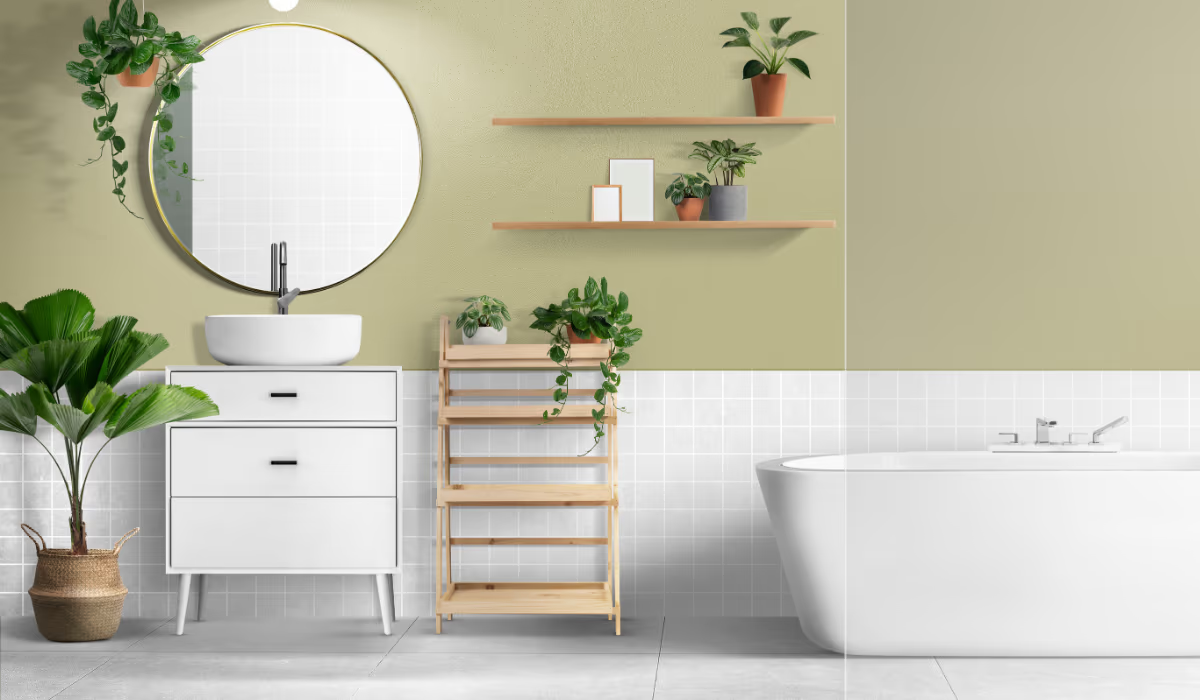Creating an inspiring bathroom design means balancing aesthetics with functionality. Whether you’re planning a full remodel or just a styling refresh, the best bathroom inspiration comes when you think about how you actually use the space. Simple design ideas can bring calm, light, and elegance, while fresher or modern touches add character and value. In this article you’ll find ideas to help you envision a bathroom that feels new, comfortable, and in harmony with your home.
Maximize Light & Openness
A bathroom design that feels larger often starts with more light and visual openness. Large windows, skylights, or cleverly placed frosted or semi-opaque glass let daylight in while maintaining privacy. Glass shower doors, rather than solid doors or curtains, help maintain sight lines and reflect light. Even small bathrooms benefit by painting ceilings white, using large mirrors, and keeping wall surfaces minimally cluttered.
Clean Lines & Minimalist Fixtures
Simple bathroom design ideas often lean toward clean, straight lines, streamlined hardware, and fewer decorative details. Floating vanities or wall-mounted cabinets give more floor space and a lighter look. Minimalist faucets and accessories in matte or polished finishes keep the design coherent and modern without excess. When you choose fewer pieces with strong design, every fixture becomes part of the visual statement.
Mixing Materials & Textures
Using a mix of materials adds interest without overwhelming a simple space. Warm woods, stone or stone-look tiles, matte metals, textured tiles, or natural stone slab walls add character and contrast. An accent wall made of tile or wood, or texture through grout lines, adds depth. Visual contrast between smooth surfaces and textures helps bathrooms feel inviting rather than cold.
Thoughtful Layout & Smart Storage
A well-designed layout improves day-to-day comfort. Group wet zones (shower, tub) away from high-traffic paths so that water from those areas stays contained. Consider niches or recessed shelving inside showers to avoid bulky shelves. Smart storage—built-in cabinets, under-sink vanities, wall niches, or mirrors with storage—helps keep countertops clean and frees visual space for a more serene look.
Statement Fixtures & Finishing Touches
Even in simple designs, a few statement pieces can elevate the whole bathroom. A striking tub shape, unique lighting fixtures, decorative mirrors, or feature tiles draw the eye. Finishing touches—like towel rails, hardware, or a bold faucet—aren’t just functional; they become part of the design story. Small, well-chosen décor—plants, artwork, or scented soaps—add warmth and personality.
Styling for Longevity & Practicality
When picking design features, think about durability and ease of maintenance. Tiles and grout should resist mold and be easy to clean. Materials that weather moisture well—sealed wood, moisture-resistant paints, and anti-rust metal fittings—reduce future repair costs. Plans that leave room to adapt (for instance, replaceable light fixtures or modular storage) help your bathroom stay fresh even as trends shift.
Conclusion
Bathroom inspiration is everywhere, but the best design ideas are the ones that match your space, needs, and lifestyle. Keeping things simple, emphasizing light, choosing quality materials, and investing in thoughtful layout and fixtures makes a big difference. Whether you’re doing a full redesign or just updating surfaces and accessories, a bathroom that feels both modern and welcoming is always within reach.
FAQs
What’s the easiest way to make a small bathroom look larger?
Using glass shower partitions, large mirrors, light colors, and good lighting helps open up the room. Minimizing clutter and keeping storage efficient makes the area feel less crowded.
Do feature tiles or accent walls become outdated quickly?
They can, depending on the style you choose. Picking accent finishes that complement the rest of your home or leaning toward timeless textures helps ensure they still look good years later.
Should fixtures match exactly for a cohesive bathroom design?
Matching isn’t necessary—what matters more is coherence in finish, style, and proportions. Slight variation (for example, mixing matte black and warm brass sparingly) can feel intentional and lively.
How important is lighting in bathroom design?
Very important. Good lighting layers (ambient, task, accent), warm light tones, and fixtures placed for both utility (mirrors, vanity tasks) and ambiance transform how the bathroom feels.
What is a bathroom design feature that offers good value?
Storage built-in niches or shelves and functional improvements (better ventilation, quality fixtures) often offer high impact without extreme cost. Styled mirrors and updated lighting likewise refresh without major remodeling.







